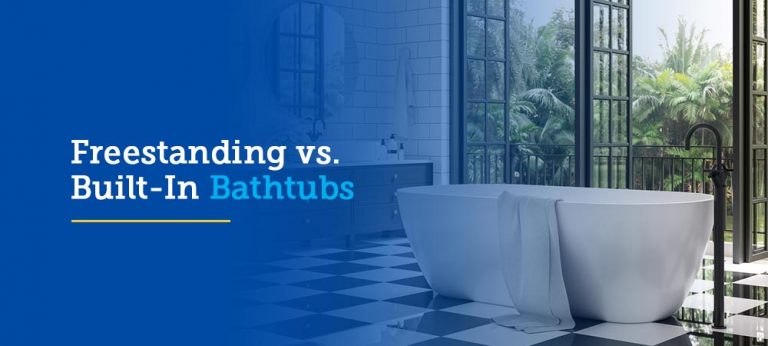Freestanding vs. Built-In Bathtubs
Planning the layout of your bathroom is exciting for new homeowners and those remodeling this space in their current residences. You can use this opportunity to create a unique ambiance in your bathroom with various styles to fit your aesthetic.
Before deciding on the appliances you need in your bathroom, consider installing a freestanding or built-in bathtub. These tub options create a relaxing ambiance that can make your bathroom come to life. Take a look at the following differences between freestanding and built-in bathtubs to see which choice is right for you.
Difference Between a Freestanding vs. Built-In Bathtub
Although both options serve the same purpose, freestanding and built-in bathtubs have several differences. From styling to placement, both tubs offer numerous options to fit your bathroom’s aesthetic.
Freestanding Bathtubs
You can place a freestanding bathtub in any area of the bathroom. Since freestanding bathtubs are deep and narrow, they can fit into tight places. The sides do not have to attach to a wall to operate, giving you free rein to decorate the space however you desire.
Freestanding bathtubs are great for fitting any interior design style, from colonial to modern. The claw-foot tub from your favorite movie can become your new place for relaxation. A contractor will install the faucet in the middle of one side of the tub for easy access to adjust the water temperature as you soak. This classy option is excellent for larger bathrooms.

Built-In Bathtubs
Built-in bathtubs are standard in most bathrooms. These tubs attach to one or more walls to fit in tighter spaces. Alcove bathtubs are standard in family bathrooms, where the three walls surrounding the tub prevent water from splashing onto the floor.
You can add drawers underneath a built-in bathtub to create storage for bathroom essentials such as towels, soap and cleaning supplies. You can also achieve an elevated-style tub for a modern bathroom aesthetic.
Pros and Cons of Built-In Bathtubs
A few pros and cons of built-in tubs and freestanding tubs may influence your decision. Consider the following points to see which type of tub fits your styling preferences best.
Pros of Built-In Bathtubs
Installing a built-in bathtub can help create a gorgeous bathroom that follows your everyday routine. Consider how this option can fit into your life and optimize your space, design preferences and cleaning methods:
- Easily pairs with showers: Many built-in bathtubs sit against a wall with a shower head so you can choose between taking a shower or bath in the same space. This versatility is essential for homeowners who prefer variety. Using the shower head during bathtime can help minimize messes if you have children or pets.
- Easier to maintain: Built-in bathtubs will only have one, two or three sides for you to clean. Since at least one side is permanently attached to the wall, you will only need to spray and wipe the inside and outward-facing sides of the tub.
- Versatile for any size bathroom: Built-in bathtubs are great for bathrooms of any size. These tubs don’t take up much space, leaving room for you to walk around the bathroom. When the bath is attached to the wall, you can place it in the corner of the bathroom to optimize space. Homeowners with smaller bathrooms can benefit from this bathtub option.
- Optimizing safety: Installing built-in bathtubs can help prevent falls. Having walls nearby lets you install handlebars you can reach while sitting in the tub, making it easier for those who need extra support to stand up after a long soak.
- Dozens of design options: You have numerous ways to style these bathtubs. Modern built-in bathtubs have straighter edges to create a sleek, minimalistic style, and you can install larger tubs to replicate a jacuzzi from the comfort of your bathroom. There are limitless design options to choose from when designing your perfect tub.
Cons of Built-In Bathtubs
Although built-in bathtubs only have a few downsides, it is essential to glance at the requirements that these tubs need during installation:
- Longer installation process: Although installing a built-in bathtub is common, the process can take longer than a freestanding bathtub because of the changes you’ll need to make. If you have tiles on your bathroom walls, a contractor must remove each one before installing the tub to ensure the side can properly attach to the wall. This process can take longer if you install a shower head or rod against a nearby wall.
- Limited placement options: Since built-in bathtubs need at least one attached wall, you may have fewer options for installing one than you’d have for a freestanding tub. Many homeowners choose to set their bathtubs in a corner to optimize the space as much as possible.
Pros and Cons of Freestanding Bathtubs
The pros and cons of freestanding bathtubs differ from their built-in counterparts. Read on to learn more.
Pros of Freestanding Bathtubs
This option can benefit your bathroom space and make your vision for the perfect remodeling job come to life with:
- Easier installation: Without the need to attach to a wall, freestanding bathtubs have a shorter installation process than built-in bathtubs. Once you and your contractor select an area in your bathroom to install the tub, they can begin installing the plumbing in the floor next to where to tub will sit.
- Placement flexibilities: You have more options for placing a freestanding tub to maximize your design preferences. Some homeowners even opt to put the tub in the middle of the bathroom to recreate the luxurious aesthetic found in mansions and castles.
- Optimizing space: Freestanding tubs are slim to make your bathroom appear more spacious. These bathtubs are a great way to maximize your space while enjoying the luxuries of a comfortable soak.
- Design options: Since freestanding bathtubs can function independently in any space of your bathroom, you have a wide selection of design options to fit with the rest of the room. You can fit a luxurious cottage-style aesthetic with a claw-foot tub or a modern, minimalistic style with a sharper-edged bath, with options for every other aesthetic in between.
Cons of Freestanding Bathtubs
Homeowners may notice some common problems with freestanding baths that differ from those of a built-in tub. Consider these few downsides to see if this option is right for you:
- Limited space for showers: While some homeowners ask their contractor to install a shower head on the ceiling above their freestanding bathtub, this choice is less common and takes longer to install. If you choose a freestanding bathtub, you should consider whether you want to install a separate shower in your bathroom or forego one altogether.
- More expensive: A professional must build all four sides and the underside of a freestanding tub before its installation, causing the price of this option to increase. However, the installation process is cheaper than built-in bathtubs.
Limitless Renovation’s Bathroom Remodeling
Is a freestanding or built-in bathtub part of your vision for the perfect bathroom? Limitless Renovation can help make these dreams a reality. With 18 years of bathroom remodeling experience, we pride ourselves on our friendly customer service and thorough installation processes.
You can be a part of every step of the remodeling and installation process to ensure your satisfaction with the final product. Organization, communication and trust are our top priorities in creating a stunning bathroom for you and your family to enjoy.
Fill out our online form to schedule a free in-home shopping experience.



